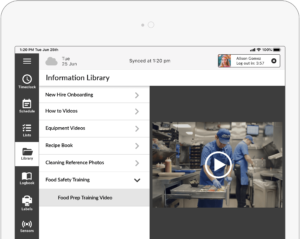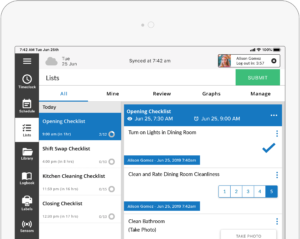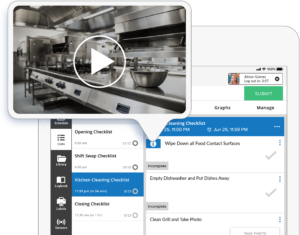Multi-location restaurant owners have different concerns than a single-unit owner.
Of course, they still want to cover the fundamentals to ensure profitable stores, but they also need to guarantee the same, great customer experience across several locations.
Moving from paper to digital restaurant operations helps multi-unit owners maintain the same training, checklists, and operations from store to store. That means all your employees will have instant access to the same best practices, and you can update them any time.
Digital operations also gives owners and management unrivaled visibility over each store, because Jolt digital checklists are updated in real time. Not only will management know that an item is done, they’ll see when and who did it.
That’s gives a serious boost to employee performance in all your stores.
Below, we’ve outlined how multi-unit restaurant owners can benefit from moving from paper to digital operations to ensure employees get the same training—and tasks—at every store.
Make Best Practices Accessible to Every Employee at Every Store
It doesn’t matter if you’re a franchisee or have your own, independent restaurant brand: you’ve worked for years to pare down and perfect your best practices.
You know what works, and what doesn’t. Most of all, you know what’s absolutely critical for employees to learn, and stress that to your management teams.
To ensure all your store are top-performers, you’ll need to take those best practices you’ve earned through years of restaurant experience, and make them accessible to every single employee.
That means every employee, at every store.
If those best practices are in videos, that’s great. If they’re on laminated cards, that’s fine too. Whatever you’re using to communicate the right way to do something, you can transfer to a digital medium.
Instead of videos employees only watch when they’re first hired, or binders of instructions in the back office, give employees access to a searchable database of every best practice in your restaurant.
The Jolt training library can house all your critical documents in a place where employees can—and will—find them.
Every store subscribed to your Jolt account can access these same files. No mailing new laminated cards or sending your managers to Kinkos.
You’ve already got these training materials on hand, they’re just not accessible, and so they’re not followed.
The more accessible your training materials, the more likely they are to be followed in every store.
Jolt’s training library can house all your best practices in one place.

Moving your best practices from paper to a digital medium will give all your employees access to the same training.
And with support from your management team, employees will immediately look to Jolt for the answer.
Giving every employee direct access to your best practices will result in more employees being educated the right way, and more consistent experiences across your stores.
The Same Operations Won’t Always Deliver the Same Accountability
Beyond the best practices you’ve created, there’s also the day-to-day operations of the store.
These are usually checklists you’ve fine tuned across your first couple stores, and now record on paper at each location.
That said, having the same checklists at each store doesn’t mean you’ll have the same success.
Checklist completion rates will be significantly lower at your poorest performing stores, and likely above 90% at your location producing the most revenue.
It’s not the processes that need to spread to the other stores. It’s the accountability.
You’ve likely got a crew of high-performing employees at the top store, where each employee is accountable for their daily tasks.
Moving those tasks from paper to digital checklists will improve those completion rates, and as a result, team accountability.
Digital checklists use features like name and timestamps to guide employees toward a culture of accountability in that store. Where paper just allows for a checkmark or initials, Jolt gives a complete breakdown of each checklist, it’s completion rate by day, and which employees are pulling the most weight.
Combining this with features like photo-proof in a digital checklists, and you’ve got the scaffolding for accountable employees in every store.
Jolt digital checklists update in real time to improve team accountability.

Combine Your Best Practices with Daily Checklists
Let’s say you’ve moved all your training materials and best practices over to Jolt. Employees can now access them anytime, and best practices are being followed more closely.
You’ve also moved your daily operations and checklists from paper to digital, and have reaped the rewards of improved visibility and accountability.
To make the most of your move to digital, you can embed training materials inside checklists, putting best practices just one click away.
Employees encountering a new or unfamiliar task won’t even have to leave the checklist they’re on to access a “how to” video, or that sheet with all the measurements on it.
It’s all right there, inside the checklist they’re completing.
With best practices that close, all your stores will be more educated on brand standards, and your well-earned years of restaurant operations will finally manifest at every location.
In Jolt, training best practices can be put directly inside daily checklists.

The Future of Restaurant Operations Is Digital
Multi-unit owners across America use Jolt every day to ensure their employees are trained properly and critical tasks are being completed the right way.
The advantage of digital operations is clear: improved employee accountability, and better visibility for management.
Multi-location owners for brands like Chick-fil-A, McDonald’s, and Buffalo Wild Wings all use Jolt daily to maintain brand standards and employee training.
To start improving team accountability across all your restaurant locations, request a free, personalized demo of Jolt Software here.
We’ll show you how to move from paper to digital to get more visibility over your business.